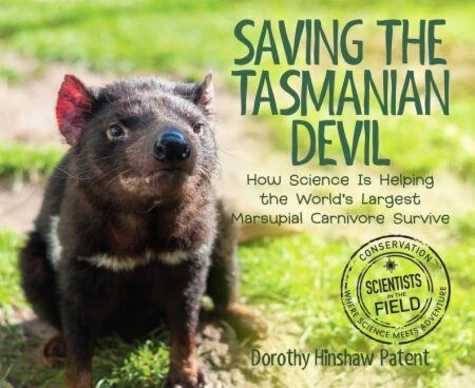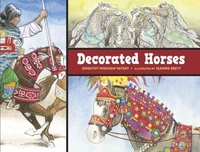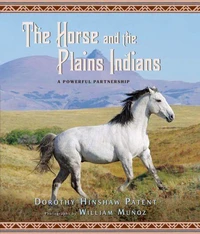Saving the Tasmanian Devil. How Science Is Helping the World's Largest Marsupial Carnivore Survive
Par :Formats :
Disponible dans votre compte client Decitre ou Furet du Nord dès validation de votre commande. Le format ePub protégé est :
- Compatible avec une lecture sur My Vivlio (smartphone, tablette, ordinateur)
- Compatible avec une lecture sur liseuses Vivlio
- Pour les liseuses autres que Vivlio, vous devez utiliser le logiciel Adobe Digital Edition. Non compatible avec la lecture sur les liseuses Kindle, Remarkable et Sony
- Non compatible avec un achat hors France métropolitaine
 , qui est-ce ?
, qui est-ce ?Notre partenaire de plateforme de lecture numérique où vous retrouverez l'ensemble de vos ebooks gratuitement
Pour en savoir plus sur nos ebooks, consultez notre aide en ligne ici
- Nombre de pages80
- FormatePub
- ISBN978-0-358-05605-8
- EAN9780358056058
- Date de parution20/08/2019
- Protection num.Adobe DRM
- Infos supplémentairesepub
- ÉditeurClarion Books
Résumé
In this addition to the critically acclaimed Scientist in the Field series, Dorothy Patent follows the scientists trying to put a stop to a gruesome disease before it's too late. Tasmanian devils are dying at an alarming rate from a type of tumor that appears to be contagious. What scientists are learning while researching the Tasmanian devil has potential to affect all animals, and even humans, as they learn more about how to prevent and hopefully eradicate certain genetic diseases.
In 1995, a deadly disease began sweeping across the Australian island state of Tasmania, killing every infected Tasmanian devil. The disease moved so fast that some scientists feared the species would be wiped out in the wild within a few decades. Where did this disease, named Devil Facial Tumor Disease, come from? What caused it-a virus, bacteria, or something else? How did it pass from one devil to another? What could be done to fight it? When author Dorothy Hinshaw Patent learned of the race to save the devil from her friend, Australian geneticist Jenny Graves, she felt compelled to travel to Australia to learn firsthand from scientists what they were finding out about these iconic Tasmanian animals and what they were doing to help it from disappearing in the wild.
Follow Dorothy as she takes readers on a fascinating journey into the Australian mainland and Tasmania, visiting parks and wildlife refuges and joining geneticist, ecologists, and other researchers as they work tirelessly to save Tasmania's unique icon.
In 1995, a deadly disease began sweeping across the Australian island state of Tasmania, killing every infected Tasmanian devil. The disease moved so fast that some scientists feared the species would be wiped out in the wild within a few decades. Where did this disease, named Devil Facial Tumor Disease, come from? What caused it-a virus, bacteria, or something else? How did it pass from one devil to another? What could be done to fight it? When author Dorothy Hinshaw Patent learned of the race to save the devil from her friend, Australian geneticist Jenny Graves, she felt compelled to travel to Australia to learn firsthand from scientists what they were finding out about these iconic Tasmanian animals and what they were doing to help it from disappearing in the wild.
Follow Dorothy as she takes readers on a fascinating journey into the Australian mainland and Tasmania, visiting parks and wildlife refuges and joining geneticist, ecologists, and other researchers as they work tirelessly to save Tasmania's unique icon.
In this addition to the critically acclaimed Scientist in the Field series, Dorothy Patent follows the scientists trying to put a stop to a gruesome disease before it's too late. Tasmanian devils are dying at an alarming rate from a type of tumor that appears to be contagious. What scientists are learning while researching the Tasmanian devil has potential to affect all animals, and even humans, as they learn more about how to prevent and hopefully eradicate certain genetic diseases.
In 1995, a deadly disease began sweeping across the Australian island state of Tasmania, killing every infected Tasmanian devil. The disease moved so fast that some scientists feared the species would be wiped out in the wild within a few decades. Where did this disease, named Devil Facial Tumor Disease, come from? What caused it-a virus, bacteria, or something else? How did it pass from one devil to another? What could be done to fight it? When author Dorothy Hinshaw Patent learned of the race to save the devil from her friend, Australian geneticist Jenny Graves, she felt compelled to travel to Australia to learn firsthand from scientists what they were finding out about these iconic Tasmanian animals and what they were doing to help it from disappearing in the wild.
Follow Dorothy as she takes readers on a fascinating journey into the Australian mainland and Tasmania, visiting parks and wildlife refuges and joining geneticist, ecologists, and other researchers as they work tirelessly to save Tasmania's unique icon.
In 1995, a deadly disease began sweeping across the Australian island state of Tasmania, killing every infected Tasmanian devil. The disease moved so fast that some scientists feared the species would be wiped out in the wild within a few decades. Where did this disease, named Devil Facial Tumor Disease, come from? What caused it-a virus, bacteria, or something else? How did it pass from one devil to another? What could be done to fight it? When author Dorothy Hinshaw Patent learned of the race to save the devil from her friend, Australian geneticist Jenny Graves, she felt compelled to travel to Australia to learn firsthand from scientists what they were finding out about these iconic Tasmanian animals and what they were doing to help it from disappearing in the wild.
Follow Dorothy as she takes readers on a fascinating journey into the Australian mainland and Tasmania, visiting parks and wildlife refuges and joining geneticist, ecologists, and other researchers as they work tirelessly to save Tasmania's unique icon.






